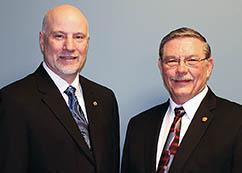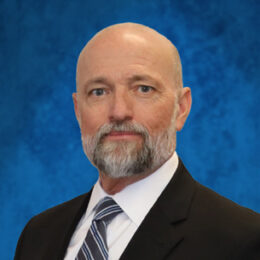 Safety
Safety
Last year was an outstanding year for the cooperative. This year, we continued with our outstanding safety record, which means all our employees are dedicated to working safely and going home to their families each day.
Operating margins improved from the prior year and expenses were maintained at below peer levels.
Reliability
Plant investment continued to be strong, as the cooperative rebuilt and replaced 30 miles of old electric line. During the year, the Ottoville substation was completely rebuilt, as was the entire Miller City service area. These improvements will provide long-term reliability while simultaneously preparing the system for future growth.
Upgrading our utility plant has been a prime focus for several years. The standard life expectancy for poles, wires, and other hardware is typically 30 years — not counting system growth, which may cause facilities to be upgraded sooner. The cooperative has nearly 1,700 miles of utility lines. A 30-year cycle would indicate replacement of 56 miles every year just to keep up. However, lines don’t all age the same, area growth is different, and priorities change over time; this means a systematic rotation and replacement schedule is necessary to address the critical areas. We maintain a study that looks at age, number of members and loading, outage history, and type of wire to determine which areas or lines should be rebuilt each year. This allows us to better allocate financial resources to higher-priority areas — instead of just replacing the oldest lines. (Some of the oldest lines are still operating in fine order with no need for replacement.)
Each year, the cooperative spends between $5 million and $6 million to upgrade these facilities. Part of the upgrades include major projects like substation rebuilds. In 2017, the Ottoville substation was totally rebuilt, costing more than $1 million. Now the substation’s service will be improved and should meet our needs for a long time into the future.
Miller City upgrade
Another major project was in Miller City. This project entailed rebuilding and replacing all the facilities located in the town, most of which were over 40 years old. Instead of doing a piecemeal job of fixing things here and there, it was decided a full rebuild was the most cost-effective way to address the serious aging problem.
Right-of-way clearing
A major part of our maintenance program is right-of-way clearing — cutting trees and brush away from power lines. Trees continue to be a major source of power outages, especially dead ash trees. During the year, our tree removal contractors cut and pruned 371 miles of right-of-way. This is the largest single maintenance expense the cooperative incurs. It is also the most necessary of programs. Continuing to address our trees and maintaining proper clearance from the electric lines will provide greater reliability and fewer outages in years to come.
Quality electric service
Rebuilding lines, upgrading substations, and trimming trees addresses the most important parts of our mission statement. Providing “quality electric service” and providing “superior customer service” are two of the goals from our mission statement. If we do not provide a high degree of reliability, we are not meeting those two objectives in our mission statement.
In 2013, members experienced over 600 outage minutes. That means each member was out of power for over 10 hours! That was not quality electric service, and it wasn’t providing superior customer service. However, in the few years since, through hard work and financial investment, we have greatly improved reliability. In fact, during 2017, PPEC members experienced just over one hour of electric interruption. The cooperative went from over 10 hours of outage time to just over one hour. This is a tremendous improvement. By comparison, in 2013, we were one of the worst in Ohio for service reliability. Today, we stand as one of the best, now in the top five for the fewest outage hours in the Buckeye State.
Community solar
Another component of our mission statement is “sustainable energy solutions.” This year, we addressed that important issue by installing our first community solar project in Paulding. The program was rolled out and quickly over-subscribed. Our project included 279 solar panels that members could purchase the output from and pay for the cost. Therefore, members interested in solar energy could enjoy the green benefits while other members were not asked to subsidize the cost.
This program speaks directly to the cooperative model: members coming together to support a project, paying the cost themselves, and not placing the burden on other members. We will be working with Buckeye Power, our power supplier, to see if future community solar projects can be developed in our service territory, allowing more members to enjoy the sustainable energy solutions afforded by this program.
Fair and reasonable rates
The final piece of our mission statement includes “fair and reasonable rates.” For a long time, we have touted the cooperative as a low-cost energy provider. Even with all the improvements, PPEC continues to be one of the lowest-cost electric providers in both states where we serve (Ohio and Indiana). In fact, during a 2016 financial ratio study by a national organization, Paulding Putnam ranked 23rd out of the 25 electric cooperatives in Ohio for residential rates. For small commercial rates, we fared better at 24th out of 25 co-ops. Finally, for large industrial rates, we ranked 17th out of 22 cooperatives (not all Ohio co-ops have large industrial members). PPEC continues to be one of the lowest-cost providers.
Maintaining low rates while continuing to improve our system and reduce outage times is tough to balance. This year, we conducted a cost of service study (COSS), which is used to verify that all rate classes are paying their fair share of the cost to operate the electric system. The COSS looks at each type of service the cooperative provides and determines the cost incurred by each class. For instance, residential members have smaller services (transformers, meters, etc.) than a commercial or industrial customer may have. Obviously, it takes a much larger service to provide electricity to a factory than it does a single-family home. The COSS helps identify all those cost differences and distinguishes how different member classes use power. Again, large industrial users are very different from residential users.
Following the COSS, it was determined that a small rate adjustment was needed. Over the past several years, changes in how our wholesale supplier billed the cooperative had changed. The COSS helped identify rate changes to match the wholesale billing changes. Overall, the changes were very small. The PPEC board of trustees approved a revenue increase of 2.75 percent, along with changes to the monthly service charge and changes to many demand and energy rates for those members billed under demand rates. These new rates will allow the cooperative to more accurately recover the costs of wholesale power purchases from Buckeye Power.
Increasing rates is never an easy decision for the board. That is why we do a COSS to ensure we have accurate information to base decisions on. This increase, which went into effect in March 2018, is the first increase in 4 years. The increase adds just over $3 to each residential member’s bill. Although this is a slight adjustment in rates, we are sensitive to our members’ budgets. Maintaining fair and reasonable rates is a priority for PPEC. Maintaining our system and ensuring a high degree of reliability is also a priority. By blending these two priorities, we can maintain a high-functioning, financially sound cooperative that meets all its mission goals.
Financials
When reviewing the financial operating reports, the cooperative is in very good financial shape. Operating margins (money left over after all expenses, which is used to invest in our utility plant) were very good at just over $2.5 million. This was down slightly from 2016 but was ahead of budget. Expenses were slightly ahead of budget for the year, as capital credits received from Buckeye Power exceeded budget and the prior year and totaled $1.8 million. Combining the operating margins and the Buckeye Power patronage, total margins for 2017 exceeded $4 million. The utility plant investment continued as was stated earlier in the report; the total plant now exceeds $95 million. Cash flow and cash balances have improved, and no additional loan funds were advanced during the year. Overall, the cooperative maintained very high financial ratios.
It is a great honor to serve the membership. We had an outstanding 2017 with excellent financial performance and outstanding reliability. On behalf of all the cooperative trustees and employees, we are grateful for your continued support and patronage. Thank you for the great year we had in 2017, and we look forward to meeting your needs and our mission goals in 2018.
George Carter
President/CEO
Dr. John Saxton
Chairman of the Board



